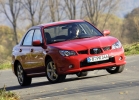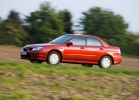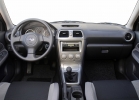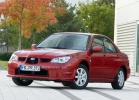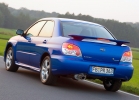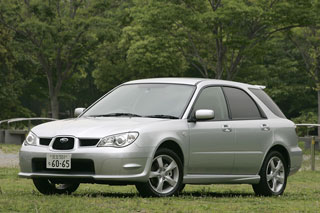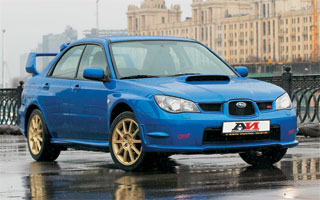Subaru Impreza 2005 test drive - 2007 sedan
Third wheel
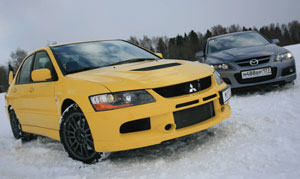 Winter this year dragged on at the end of March Naked asphalt pleased only urban residents. Yes, and then rarely. It was at the end of the long winter that we managed to assemble 3 Japanese cars together, which, in fact, are the best of what Subaru, Mitsubishi and Mazda can offer today. The sedans of the first two companies do not need an idea. The annual exit of their new versions of Rally-Style tradition. Evolution and WRX STI sworn competitors in the genre, at one time by the same models and created.
Winter this year dragged on at the end of March Naked asphalt pleased only urban residents. Yes, and then rarely. It was at the end of the long winter that we managed to assemble 3 Japanese cars together, which, in fact, are the best of what Subaru, Mitsubishi and Mazda can offer today. The sedans of the first two companies do not need an idea. The annual exit of their new versions of Rally-Style tradition. Evolution and WRX STI sworn competitors in the genre, at one time by the same models and created. This time a serious couple complemented the Mazda6 MPS. I must admit, most of all conversations before the start of the test was the correctness of its comparison with Evolution IX and WRX STI. We took a fundamental position comparison is appropriate and necessary. Yes, Mazda is 170 kg heavier than Subaru. Yes, the distance between its full -wheel drive and the Mitsubishi transmission is akin to the strait between continental Europe and the British islands, it seems to be not far from, but try to swim, but all this is known only to car journalists and even a small handful of so -called advanced flights. And many potential consumers, for the first time having heard about the new Driving Japanese car with a 260-horsepower turbo engine, are all-wheel drive and a price of $ 43,000 first of all, which is worse or better than Evolution and WRX STI. It is no less interesting who, in a pair of cars with a rally genealogy, is preferable.
So it’s good that winter dragged on. We got the opportunity to check the combat three in combat conditions on ice and snow.
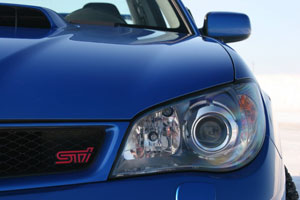 Subaru Impreza WRX STI
Subaru Impreza WRX STI Samurai! This common label first came to mind when I saw Subaru. However, the car did not immediately become so spectacular. No matter what they say about Japanese design, Impreza’s new generation began to look truly interesting and finished only after the second, European restyling, when it was touched by the hand of the Greek Blatinas of the author of the style of all modern Subaru.
The front part was especially successful. Ksenon's predatory eyes, convincing false radiator grille. In the center, the shield, on the sides of the holes, which, according to the creators, should remind of the aviation past Fuji Heavy Industries. However, it seems to me, this technique will remind me of this past. But this is not so important. The main thing is beautiful.
The hump of the air intake on the new WRX STI became lower by 19 mm. The sidewalls have changed here new thresholds, and plastic overlays appeared on the rear arches. A controversial solution ... The most functional change in appearance should be recognized as a small curved spoiler above the rear window. He directs the flow of the raising air straight to the shelf of a large anti -wing on the lid of the lamp of the aerodynamics is more perfect, which is well felt at high speed when Impreza seems to stick to the road. The car is blue to the face, in the arches, gold wheels are traditionally located for Subaru.
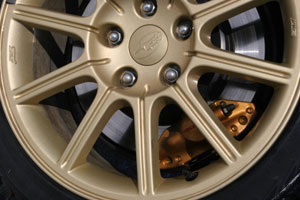 Inside a short list of joys of life. There is a radio with a CD player, climate control, watch. There is no onboard computer. Coal adjustments are mechanical, there is no heating. But you can set the engine speed, upon the achievement of which the red light will begin to flash on the tachometer. Comfortable.
Inside a short list of joys of life. There is a radio with a CD player, climate control, watch. There is no onboard computer. Coal adjustments are mechanical, there is no heating. But you can set the engine speed, upon the achievement of which the red light will begin to flash on the tachometer. Comfortable. The lighting of the devices is red, the brightness of the glow is adjustable in the large range. But the font on the silver central console shines poisonous green. A strange combination. By the way, the tachometer occupies a central place on the dashboard, the speedometer huddles on the right. On the tunnel between the keys the key and the wheel for managing the operation of the DCCD center differential. There is no stabilization system on this machine, respectively, there is no button of its disconnection.
The decoration materials are rustic, only a peppy blue-black color saves. But the quality of the assembly is at a height. Impreza salon is the closest of the three. In internal dimensions, this is a representative of the Golf class of the old school. Fifter is better not to ride. However, even four of the four -sewing, the front chairs are propping up the back of the back seats. But the scope of the least worries me. The driver behind the wheel is convenient, and this is the main thing. I turn the ignition key, and under the hood begins to mutter a 2.5-liter turbo-optical pride of Subaru. Evil metal notes are distinguishable in his voice. While the motor warms up, I twist it several times, getting great pleasure from this soundtrack. Definitely, from our three, the most rich, thoroughbred sound, in STI.
The short -flowing mechanism of the checkpoint allows you to change gear with jewelry accuracy. The clutch works impeccably the pedal informative, the mechanism acts quickly enough, at the top. What is needed for operational switching. The accelerator pedal pleases with unambiguous reactions with a minimum delay that can be felt in the low -speed zone. It should be noted that the STI is equipped with a new 6-speed gearbox, Evo IX tried similar to mechanics. The machines have grown power synchronously. And there were black diffusers in the rear bumers. In general, competitors try to keep up with the times (read with each other).
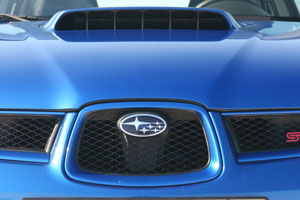 In theory, the increase in the volume of the WRX motor should provide smooth characteristics of the motor, more traction in the entire speed range. This is true. But only compared to the previous WRX STI. But the comparison with Evo IX turns against Impreza. A larger engine has less thrust below, up to 3,000 revolutions. Moreover, this is clearly noticeable with full -time comparison, you just have to transfer from Mitsubishi to Subaru. The EVO motor has a smaller operating volume, but is distinguished by a more gentle characteristic of torque, and it is better at the output. As for Mazda, its motor is clearly weak only at the very bottom, when you need to move off. Unwinding, he quickly gains strength and gives all his Newton meters to 3000 rpm. MPS power unit is the most even of all. The engines of her rivals are explosive without exaggeration.
In theory, the increase in the volume of the WRX motor should provide smooth characteristics of the motor, more traction in the entire speed range. This is true. But only compared to the previous WRX STI. But the comparison with Evo IX turns against Impreza. A larger engine has less thrust below, up to 3,000 revolutions. Moreover, this is clearly noticeable with full -time comparison, you just have to transfer from Mitsubishi to Subaru. The EVO motor has a smaller operating volume, but is distinguished by a more gentle characteristic of torque, and it is better at the output. As for Mazda, its motor is clearly weak only at the very bottom, when you need to move off. Unwinding, he quickly gains strength and gives all his Newton meters to 3000 rpm. MPS power unit is the most even of all. The engines of her rivals are explosive without exaggeration. Therefore, everything that is below 3000 remains for urban traffic jams. And as soon as the free section of the highway appears, I don’t think about it, I am entering the motor in each gear. And God with them, with empty bottoms, is a turbine under 3000 revolutions excellent compensation. Acceleration pulls out the car out of reality, powerfully takes forward. Quick switching, in the next gear it seems that acceleration is even more intense. By the way, according to the Impreza passport, EVO brings EVO to accelerates to hundreds of 0.3 seconds with equal power and a smaller moment. Overflowing on this machine is given incredibly a short extension, the turbine is spinning, a reduced step is inserted into the clip, and the car flies forward under the song of an angry opposition.
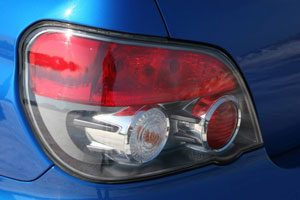 Impreza STI has the most energy -intensive suspension, which, with all its sports, also provides excellent comfort. The machine demonstrates amazing exchange rate stability and disregard for a broken road and deep ruts. And this is on a wide winter studded rubber! Parse, crooked hatches and metal seams turn into a smooth surface, a stain of contact of tires with the canvas remains stable even on an arc, where irregularities, as a rule, quickly throw off sports cars from the trajectory. And the suspension works quietly and at the same time pleases with a composure and there is no hint of buildup! The car only abruptly throws the riders on the waves. For Russian operating conditions, the chassis of the STI in our comparison is a preferred option. Lancer is shaking and hard, but his steering wheel is precisely accurate. In Impreza, it is less acute and seems slightly cotton, the feedback is not so transparent, but less blows are transmitted to it.
Impreza STI has the most energy -intensive suspension, which, with all its sports, also provides excellent comfort. The machine demonstrates amazing exchange rate stability and disregard for a broken road and deep ruts. And this is on a wide winter studded rubber! Parse, crooked hatches and metal seams turn into a smooth surface, a stain of contact of tires with the canvas remains stable even on an arc, where irregularities, as a rule, quickly throw off sports cars from the trajectory. And the suspension works quietly and at the same time pleases with a composure and there is no hint of buildup! The car only abruptly throws the riders on the waves. For Russian operating conditions, the chassis of the STI in our comparison is a preferred option. Lancer is shaking and hard, but his steering wheel is precisely accurate. In Impreza, it is less acute and seems slightly cotton, the feedback is not so transparent, but less blows are transmitted to it. The brakes are excellent. Large pancakes, coupled with Brembo machines, do their job impeccably. But ABS is roughly unpleasantly cutting his teeth on the brake pedal. EBD distributes the force competently. When braking on a slippery coating with a heterogeneous surface, the machine does not go astray from a direct course. In turns, this system is also useful for the car to turn around.
Claiming in the city stream, of course, is interesting. It’s also interesting to accelerate from traffic lights, reveling in an effective start, even on a slippery coating, Impreza, a little wagging the stern, quickly goes forward. But the salt is to try the car in slipping. For which, in fact, a sortie was organized on a specially prepared autodrome. (Our partner during a two -day test was the center for contrasting training of drivers of a master class led by Alexei Kolontai).
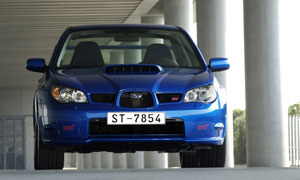 In drifts, the behavior of WRX STI is logical and predictable. The impression of a computer game is created, where the virtual car fulfills your requirements in accordance with the laid software code.
In drifts, the behavior of WRX STI is logical and predictable. The impression of a computer game is created, where the virtual car fulfills your requirements in accordance with the laid software code. The switches on the central tunnel control the operation of the center differential and allow you to quite change the character of the car. The icon in the left side of the dashboard shows which mode is involved. By default, this system itself controls the differential. You can turn on the full lock mode, and then gradually dissolve the differential, twisting the wheel. Only 6 steps. In the lower position, the differential is completely dissolved, and this is the most gambling option. Subaru tends to excess turning under the traction. Accordingly, varying the degree of locking, the nature of the rotation can be changed.
A full -wheel drive transmission perfectly understands the driver in Auto mode. And with a blocked differential, Impreza becomes a car with linear reactions to the supply of fuel and rotation close to neutral. For a gas reset, the car willingly screw into the turn. If you roll, first, the front axis is demolished, which can be corrected either by the discharge of gas or its addition, the help of the rear axle will become more pronounced, and the machine will go into sliding with all four wheels. And it will make it softly.
It is very pleasant to work the steering wheel in such modes. The hydraulic booster acts impeccably, and the effort on the steering wheel always accurately informs the driver about the position of the front wheels.
The first day of the test program was completely dedicated to Impreza. The car conquered his handling, I almost fell in love with him. However, in the reserve there was another test day, when rivals were supposed to pull up on the car. I wonder what these two are capable of, how will they manifest themselves in comparison with WRX STI?
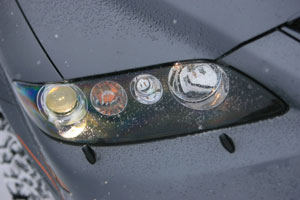 Mazda6 MPS
Mazda6 MPS Six looks next to Evo IX and WRX STI quite organic. Even despite the fact that it does not hypnotize passers -by bottomless air intakes and multi -storey anti -wingers. Modesty decorates. Those who are in the know will say everything by a humpbacked hood under which the intercooler hid, and a black diffuser peering out from under the rear bumper. But 2 large -caliber bells of the exhaust in fact turned out to be fake, inside them are rather modest pipes. Opponents have much more serious trunks. However, the configured acoustics of the release is still formidable and intriguing. Subaru and Mitsubishi engines are good, to say. However, the Mazdovskaya 2.3-liter four, which acquired a turbine, almost closely approached eminent opponents. The creators claim that they provided a high torque in the lower range, however, up to 2500 rpm of the engine is not capable of exploits. And all your daring rushes to demonstrate only after passing this mark only time to switch the programs. Still, the moves of the lever were smaller. Like Subaru.
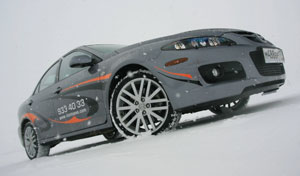 However, it is somehow embarrassed to compare these moves in this case. Take a closer look inside Mazda, the difference in the ideology of models is most noticeable. The transformation of an ordinary six into MPS on the interior was practically not reflected. Two features of the speedometer marking up to 280 km/h and aluminum pads run unnoticed by the first and even second glance. Mazda retained all its salon virtues, and the presence of these worldly joys does not at all prevent communication with a powerful and fast machine. For example, leather chairs, although they do not have the tenacity and fixation that is characteristic of Mitsubishi and Subaru buckets, are quite convenient and are also equipped with electrical regulations. The three -spoke steering wheel for the comfort of the grip is not much inferior to the sports bagels of the opponents of the MPS, and at the same time it is multifunctional. And about comfort in the second row and there is no need to talk elementary more spacious. Obviously, with regard to passenger amenities, MPS is a cut above competitors.
However, it is somehow embarrassed to compare these moves in this case. Take a closer look inside Mazda, the difference in the ideology of models is most noticeable. The transformation of an ordinary six into MPS on the interior was practically not reflected. Two features of the speedometer marking up to 280 km/h and aluminum pads run unnoticed by the first and even second glance. Mazda retained all its salon virtues, and the presence of these worldly joys does not at all prevent communication with a powerful and fast machine. For example, leather chairs, although they do not have the tenacity and fixation that is characteristic of Mitsubishi and Subaru buckets, are quite convenient and are also equipped with electrical regulations. The three -spoke steering wheel for the comfort of the grip is not much inferior to the sports bagels of the opponents of the MPS, and at the same time it is multifunctional. And about comfort in the second row and there is no need to talk elementary more spacious. Obviously, with regard to passenger amenities, MPS is a cut above competitors. 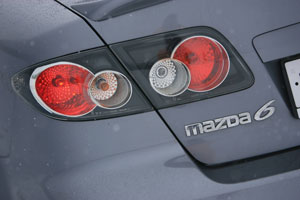 On the asphalt, Mazda6 MPS demonstrates good sled habits, obey the steering wheel, and stands confidently on both the straight line and on the arc. The steering wheel is moderately sharp, with a clear zero position and a verified reactive force. I liked the suspension of the stiffness of the front springs increased by 25%, and the rear by 26%, so Mazda behaves quite collected. But working on controllability, engineers kept comfort in mind all road irregularities remain below, only hints of them reach the body and sedocks. Perhaps, in the aggregate of suspension, MPS is quite close to Subaru, the chassis of which has a greater composure and rigidity almost without compliance with the application. Evolution is more brutal and tougher than both rivals.
On the asphalt, Mazda6 MPS demonstrates good sled habits, obey the steering wheel, and stands confidently on both the straight line and on the arc. The steering wheel is moderately sharp, with a clear zero position and a verified reactive force. I liked the suspension of the stiffness of the front springs increased by 25%, and the rear by 26%, so Mazda behaves quite collected. But working on controllability, engineers kept comfort in mind all road irregularities remain below, only hints of them reach the body and sedocks. Perhaps, in the aggregate of suspension, MPS is quite close to Subaru, the chassis of which has a greater composure and rigidity almost without compliance with the application. Evolution is more brutal and tougher than both rivals. Mazda is pierced during acceleration and braking. An intensive set of speed is accompanied by an unpleasant lifting of the nose; With each switching, he strives to fall to reach up again when the tachometer arrow gets to the turbine zone. You can deal with this only in one way with quick switching. It is just powerful synchronizers to operate with a lever with a lever that is striking ease of shifts, another thing is that this does not always help. During a measured driving, the engine manages to slide into a turboyama, and there all exactly atmospheric 2.3 liters. It makes no sense to twist the motor into the ringing, at the very top it is significantly souring. It is better to stay in the range of 30005500 revolutions.
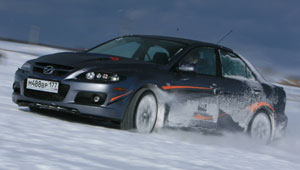 Mazda6 MPS dynamics loses, but not with a crushing score. The advantage of her rivals at the start of a distance of 0100 km/h 20 hp, and almost 2 centners of weight turn only into a second lag Mazda at the finish. And if you remember that the sweet couple Evo/STI easily leaves for 6 seconds, then one cannot but admit that the Mazda holds well as well as well. The process of the fastest speed of speed captures. During the start, the electronics quickly blocks the focus, and the MPS goes to accelerate with a hard all -wheel drive, confidently rowing with all the wheels. And it also turns out to be excellent thanks to the increased brake mechanisms and discs. The pedal force is dosed without problems.
Mazda6 MPS dynamics loses, but not with a crushing score. The advantage of her rivals at the start of a distance of 0100 km/h 20 hp, and almost 2 centners of weight turn only into a second lag Mazda at the finish. And if you remember that the sweet couple Evo/STI easily leaves for 6 seconds, then one cannot but admit that the Mazda holds well as well as well. The process of the fastest speed of speed captures. During the start, the electronics quickly blocks the focus, and the MPS goes to accelerate with a hard all -wheel drive, confidently rowing with all the wheels. And it also turns out to be excellent thanks to the increased brake mechanisms and discs. The pedal force is dosed without problems. On MPS Presentation Pokatushki, famous athletes, savoring the novelty on the snowy Tushino highway, assured that her four -wheel drive was something more than just a means of better implementation of the engine capabilities with asphalt accelerations. And in front of Mazda, again, a snowy platform with worships marked with cones, in which Impreza and Lancer were already flying before it. Acceleration, turning the steering wheel at the input MPS demonstrates the demolition of the front axle, which replaces for the discharge of gas with a rather deep skid, which must be compensated by the steering wheel in time. Now at the entrance I add gas, set the car with a small countersanos and pull in sliding in an arc. The reactions are unambiguous. The winter mode of operation of the transmission, which involves electronics in such conditions, is focused on controlled slides, requiring minimal operation of the steering wheel. Everything should remain within the framework of security, not without reason Mazda is the only subject of the subjects is equipped with a stabilization system.
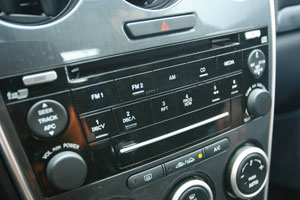 Mazda6 MPS, of course, does not get into one class with Evolution and STI. The machine is not so willing to be in charge when increasing the supply of fuel, you have to provoke it using the buildup or discharge of gas. In addition, you should make an amendment for the thoughtfulness of the accelerator, the softer suspension in critical modes does not feel completely confident, and the hydraulic power control does not have enough performance with the rapid rotation of the steering wheel.
Mazda6 MPS, of course, does not get into one class with Evolution and STI. The machine is not so willing to be in charge when increasing the supply of fuel, you have to provoke it using the buildup or discharge of gas. In addition, you should make an amendment for the thoughtfulness of the accelerator, the softer suspension in critical modes does not feel completely confident, and the hydraulic power control does not have enough performance with the rapid rotation of the steering wheel. As a result in the snow, Mazda6 MPS is not capable of magic that creates in the corner of Evolution. Mazda will be useless to many subtleties of driving an all -wheel drive car, which is necessary when managing Subaru. But the pleasure of Mazda6 MPS is able to deliver. You go around the city working quickly and comfortably, and on the weekend you go to disperse blood to some sports ground. Such a MPS scenario will support very willingly.
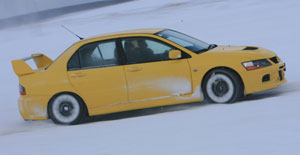 Mitsubishi Lancer Evolution IX
Mitsubishi Lancer Evolution IX The yellow sedan, no doubt, was the nail of the program. Yes, and this car arrived to the place of tests with honors on the evacuator. Because he is the first Evolution IX in Russia, and documents have not yet been drawn up for him. In addition, the Evolution IX techno brought him to the potential leaders of our impromptu competition.
While Evo stood on the pedestal, it was a sin not to admire. That's really an athlete, a harsh professional! Even a cheerful color is not able to change this aura. The look of long rectangular headlights is threatening. In an energetically bloated, armed with numerous aerodynamic elements, power is felt, but not rough, but backed up by intelligence. However, it's time for business. Pour the 98th fuel into the tank, warm the engine, and the car, bouncing on each bump, is rolled out on the autodrome.
Outwardly, the novelty differs from the previous EVO slightly. The shape of the front bumper has changed, in the back, as already mentioned, a black diffuser appeared. The false radiator grille has become simpler, darkened optics.
The front wings, the hood (as in the last version), the roof and protective bars in the doors are made from aluminum. The roof became lighter than 4 kg, and therefore the center of gravity dropped by 3 mm. According to Mitsubishi, the rolls as a result decreased as if the car lost in the mass at the hood level 12 kg! The rear a carbon fiber spoiler is hollow, which also gives a weight in weight. The hardness of the body is increased due to 200 additional welding points. The middle racks of the body, the base of the front racks, the rear wheel arches strengthened. The spacer is improved between the cups of the front shock absorbers.
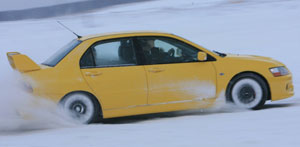 The EVO salon, as expected, has not changed much. The steering wheel MOMO is different. New chairs appeared, the pedals are equipped with aluminum overlays, on the front panel imitating Kevlar finish. At the same time, the interior took a lot from the practical family Lancer inexpensive materials, hard plastic, however, there was a place for climate control (it also is on Subaru, not to mention MPS) and automatic glass windows on all doors (on Subaru only on the driver's). But there is no music. However, this is even good. For example, Impreza will still have to get rid of the standard audio system. Perhaps someone will do it for weight loss. But in this case, this refers to the installation of a new, with a decent sound. Inside spacious. In terms of salon space, EVO can be compared with Mazda6. But acoustic comfort is the worst in the top three.
The EVO salon, as expected, has not changed much. The steering wheel MOMO is different. New chairs appeared, the pedals are equipped with aluminum overlays, on the front panel imitating Kevlar finish. At the same time, the interior took a lot from the practical family Lancer inexpensive materials, hard plastic, however, there was a place for climate control (it also is on Subaru, not to mention MPS) and automatic glass windows on all doors (on Subaru only on the driver's). But there is no music. However, this is even good. For example, Impreza will still have to get rid of the standard audio system. Perhaps someone will do it for weight loss. But in this case, this refers to the installation of a new, with a decent sound. Inside spacious. In terms of salon space, EVO can be compared with Mazda6. But acoustic comfort is the worst in the top three. The suspension, as already mentioned, is the most uncomfortable, shaking. I note that an optional Bilstein shock absorbers were installed on the car, which are slightly softer than standard Kayaba. So, in the stock on the go will be even tougher. In addition, the sedan flaunts the BBS forged disks also an option. Just some kind of German bag! For such a replacement (by default, there are familiar Japanese Enkei wheels, the design of which, in my opinion, is closer to Evo style) dealers ask for $ 4400. Well, in this case, it will be comforted by a decrease in the subressed masses.
A pleasant consequence of the dentistry of the suspension for the slightest movement of the steering wheel car without any delay responds with a clear movement. Yummy! Accelerator pedal is quite tight. It, like the steering wheel, is an instrument of increased accuracy. The adhesion pedal move is slightly less than on Subaru, and is clearly smaller than on Mazda. Well, this mechanism works, as it is easy to guess, is extremely good.
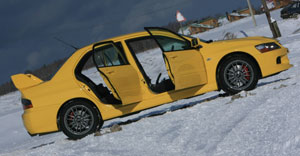 The Evolution IX has a new 6-speed checkpoint, which was created on the basis of the previous gearbox. The numbers in the transmission are selected correctly, but the moves of the lever could be made a little shorter. However, this does not matter. From improvements, it is worth mentioning cables with a Teflon coating, thanks to them it has become easier to switch. The use of the new damper reduced the level of noise and vibrations, and also extinguishes a jerk to a greater extent when changing gears.
The Evolution IX has a new 6-speed checkpoint, which was created on the basis of the previous gearbox. The numbers in the transmission are selected correctly, but the moves of the lever could be made a little shorter. However, this does not matter. From improvements, it is worth mentioning cables with a Teflon coating, thanks to them it has become easier to switch. The use of the new damper reduced the level of noise and vibrations, and also extinguishes a jerk to a greater extent when changing gears. The first trial circles have been made, the circle of drifts begins to say that Evo gives special driver sensations due to the fact that achieving mutual understanding with it is easier than with the same Subaru. Here you should run a little forward. After the test series on Evo, I immediately moved to STI, so that in hot pursuit, as they say, to feel the difference. I set up the steering wheel, moved the chair, started and for some time could not understand what happened to the car. Yesterday the sensations were different! Why doesn't she want to go when the engine revolutions are less than 3,000? Why did the gas pedal become dumped, and the feedback on the actions of the steering wheel is not so accurate?
I go to the rated turn and do the same as a few minutes ago, without straining at all, I performed on Evo. Before the entrance, I brake with 80 km/h, loading the front wheels, and immediately after turning the steering wheel to the turn of the turn I open the throttle with a completely dissolved interdosseous differential. STI begins to be screwed into the turn, but it comes wider than expected, I put it on, I'm late with the correcting of traction, and the car begins to twist around the vertical axis. I compensate for the downhole that has begun, but it is too late to avoid a turn. What is it?
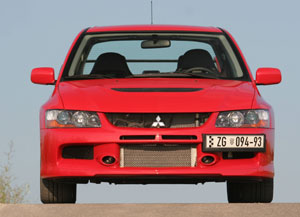 This is a visual demonstration of Super Ayc Active Rear Differentle installed on Lancer Evo. The system intervenes in the control process, redistributing the thrust between the rear wheels to the ratio of 35/65 and thereby changing the trajectory of the car and easily stabilizing it in a split second. From the side you can notice that, depending on which direction the front wheels are turned in the bend, one of the rear is spinning faster, then, on the contrary, slows down. This is the uniqueness of the car. The debugged intellectual transmission makes a considerable part of the work in the turn for the driver and allows you to be with the trajectory, which 2 other sedan cannot offer. Subaru is able to go through a turn quickly, beautifully and efficiently, but the driver will have to work more.
This is a visual demonstration of Super Ayc Active Rear Differentle installed on Lancer Evo. The system intervenes in the control process, redistributing the thrust between the rear wheels to the ratio of 35/65 and thereby changing the trajectory of the car and easily stabilizing it in a split second. From the side you can notice that, depending on which direction the front wheels are turned in the bend, one of the rear is spinning faster, then, on the contrary, slows down. This is the uniqueness of the car. The debugged intellectual transmission makes a considerable part of the work in the turn for the driver and allows you to be with the trajectory, which 2 other sedan cannot offer. Subaru is able to go through a turn quickly, beautifully and efficiently, but the driver will have to work more. Once again I want to say kind words to the power unit. It pulls well from below, and after 3000 rpm it gives out the maximum torque of 400 nm. Opponents with a larger working volume are inferior to the EVO engine not only on paper, but also in practice. However, the working volume is not so important for turbo engines.
Evolution IX is an exclusively obedient and predictable car. Managing them, rejoice and surprised at how easily everything is given. Sometimes it even seems that Evo anticipates the driver's desires. Delight, in a word.
There will be no third place, since the test was carried out according to the formula 2+1 two find out the relationship, and the third shows itself against their background and, if possible, enters into the struggle. In the dispute of Evo IX with Impreza WRX STI, we prefer the first. Yes, Impreza is a magnificent, charismatic sports car, but the Evolution IX in almost all points of the program (except for acceleration to 100 km/h) surpassed the enemy.
And what about Mazda6 MPS? Sports ambitions are evident. But this sport is of a different kind, which is evidenced by a completely different set of automotive properties. Of the comfortable sedan, no one will ever make the BOOLID N. Accordingly, and the target audience is different.
Cars provided:
Mazda6 MPS Mazda Center Kuntsevo and Mazda Representative Office
Mitsubishi Lancer Evolution IX Rolf
Subaru Impreza WRX STI Subaru Representative Office
We thank the leadership of the ski resort of Sorochany (www.sorochany.ru) for assistance in conducting tests
We thank the Center for Contradiation Training of Driver Master Classes (www.m-class.ru) for the help in preparing the material
Subaru Impreza WRX STI
Behind
Four-wheel drive. DCCD allows you to change the nature of the controllability in a wide range.
Dynamics. Shooting for a belt when accelerating to hundreds of EVO IX is worth a lot.
Motor. With the opposition, the center of gravity is lower, and the sound of the engine is amazing.
Suspension. Energy -intensive, suitable for driving on any roads.
Vs
Motor. Twisting up to 3000 rpm will be small.
Interior. The closest salon.
Steering wheel. Insufficient steering wheel adjustment in height and departure.
Result
Having overtaken Evo IX at the start, Impreza is inferior to him in the overall standings. She is very fast and obedient, but the competitor is still a little better.
Mitsubishi Lancer Evolution IX
Behind
Four-wheel drive. ACD+Super AYC allows you to be faster than all with minimal voltage.
Motor. Large torque below, a clear reaction to pressing the gas pedal.
Controllability. Sharp steering wheel, honed reactions.
Technical level. Structurally, the most advanced car in the top three.
Vs
Interior. Very, very modest, and the sound insulation is weak.
Result
The best car among the subjects is smart, raids in reactions and perfectly balanced.
Mazda6 MPS
Behind
Salon. Spacious, comfortable, modern.
Controllability. The machine does not present unpleasant surprises, simple and understandable in management.
Four-wheel drive. Despite the more simple scheme compared to competitors, an all -wheel drive transmission makes it possible to enjoy the speedy passage of slippery turns.
Vs
Steering wheel. With intensive steering, the guru lacks performance.
Suspension. Not enough composure.
Result
The car actually went outside of the offset, but it showed itself well in comparison. If you do not like the uncompromising of fighters, much more civilian, richer equipped and significantly cheaper Mazda excellent choice.
Motor compartment
Thanks to this engine, Mazda6 MPS has become the most powerful sedan in the history of the brand. In addition to turbocharged, the in -line four MZR 2.3 DISI also has a direct fuel injection. For the best hanging, the intercooler is located above the motor. Power 260 hp, torque 380 nm.
In a line 4-cylinder engine Mitsubishi 4G63 The fruit of almost 20-year evolution from excellent to excellent. At the ninth Evolution, the 2-liter engine received a system for changing the MIVEC gas distribution phase at the inlet and an elongated diffuser of the turbocharger. The result is 280 hp. and 400 nm. The Evo motor puts competitors on the shoulder blades, despite the smaller working volume.
Opposite Subaru WRX STI after increasing the working volume from 2.0 to 2.5 l caught up the EVO engine in power, but for the torque, it is still slightly inferior to it. Active Valve Control System) is available only at the inlet. Power 280 hp, torque 392 nm.
If you pay attention to car shoes, it turns out that Mazda had an advantage: its tires are the narrowest. As for Lancer, it turned out to be the best, despite the wide bast shoes.
Mazda: Nokian Hakkapeliita 4 215/45/R18
Subaru: Nokian Hakkapeliita 5 225/45/R17
Lancer: Nokian Hakkapeliita 4 235/45 R17
Transmission
Mazda6 MPS
In the all-wheel drive transmission Active Torque Split All-Whell Drive, the electronic-controlled multi-disc friction coupling performs the intericoses differential functions. For better weighting, it is installed in front of the rear inter -white differential of increased friction. The degree of locking the coupling determines the value of the torque transmitted to the rear axle. The driver is not able to intervene in the transmission, but 3 programs of standard, sports and winter are sewn in the control electronics. The control unit selects a particular program, analyzing the driver’s driving and the condition of the road surface. He receives information from the sensors of the angle of rotation of the steering wheel, rotation around the vertical axis, transverse acceleration, speed and position of the throttle. The standard regime is designed for standard traffic modes, and it is it that is active for most of the time. The coupling in the standard is almost completely open, the car in this case is essentially front -wheel drive, but in some situations, a slight fraction of the torque is supplied to the rear wheels. With a sharp acceleration, a sports program is activated, which provides a flexible redistribution of torque, up to the transfer of 50%. A winter algorithm is used in protracted slides, and then the moment is divided symmetrically 50/50.
Subaru Impreza WRX STI
The main link in the Subaru Impreza WRX STI Subaru Impreza STILLENCION Central Differential with electronic control, which allows you to manually change the degree of its lock (Drivers Control Centre Differential DCCD); Thus, the torque is distributed through the axes. The adjustment is discrete, consists of 6 positions from a completely free differential to a completely blocked. There is also Auto mode in which the degree of lock sets electronics. The differential itself is cylindrical, with an unequal division of torque. In a free state, it serves 59% of the moment on the rear wheels, 41% on the front. By the way, the STI 2005 model year has the main proportion even more asymmetric 35/65. Differential blocking is carried out using an electromagnetic coupling, and on machines of the 2006 model year, it also added mechanical (eccentric) blocking to it for the first third of the blocking range and is always active, including in manual DCCD mode. In a set of sensors transmitting information for DCCD, the steering wheel position sensor appeared. In front and behind, inter -long differentials of high friction are used.
Mitsubishi Lancer Evolution IX
The most difficult design of the three transmission. Here, 2 differentials are controlled by the electronics central and the rear inter -cross. The front worm self -locking. Active central differential (Active Center Differential ACD) shares the moment equally between the axes (Evo is more symmetrical than Subaru) and is blocked using a multi -disc supple with a hydraulic drive. ACD also provides the driver with the opportunity to change the degree of its lock, however, the choice is limited by three asphalt, gravel and snow modes. Active rear differential (Super Ayc Active Yaw Control) is able to distribute the torque between the right and left rear wheels. For example, at the entrance to the turn, he supplies a greater moment on the outer wheel, winds it, thereby reducing insufficient rotation and filling the car into a turn. By action, Super Ayc can be compared with a stabilization system that operates not with brakes, but with traction. ACD and Super AYC have a single electronic control unit and work in a close relationship. Simplified scheme: braking before turning ACD is blocked, Super Ayc twists the inner wheel; The entrance to the ACD turn is dissolved, Super Ayc turns the outer wheel; The output from the ACD is blocked, Super AYC loads the outer wheel with the moment. A source: Motor magazine [April 2006]
Video Crash tests Subaru Impreza 2005 - 2007
Subaru Impreza 2005 test drives - 2007
Malfunctions Subaru Impreza 2005 - 2007
Subaru Impreza malfunctions: Detailed information| Impreza 2005 - 2007 | |
|---|---|
| Engine |  |
| Transmission |  |
| Control system and suspension |  |
| Brake system |  |
| Air heating and air conditioning |  |
| Launch and charging system |  |
| Electric components and so on |  |
| Corrosion body stability |  |

